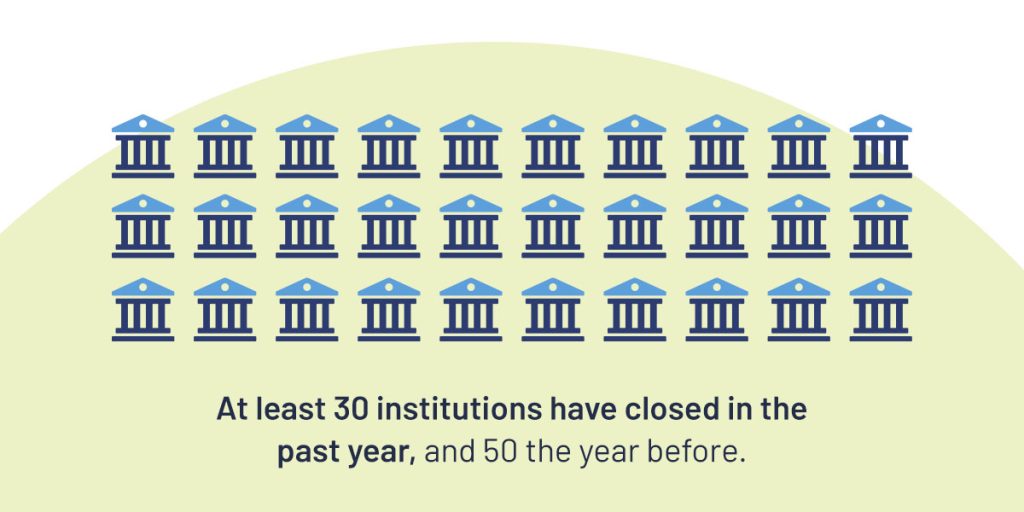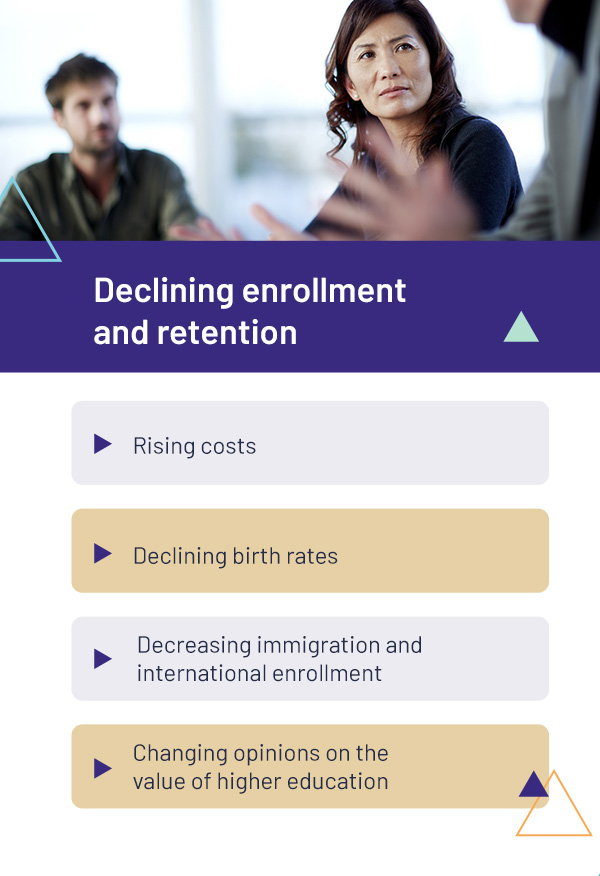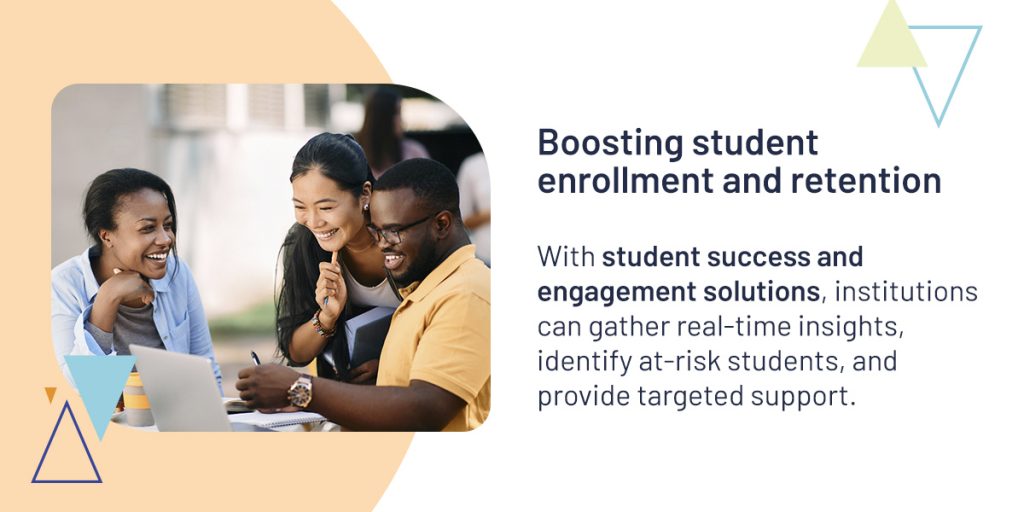
Today’s higher education institutions face uncertainty due to the widespread closing of colleges. Amid a bout of college closings, the remaining institutions are rethinking their long-term viability. These closures have a devastating impact on students and faculty. They’ve become so frequent that students moving from one closed college may need to move again, meaning spending more time and money on their education.
Institutional decision-makers are creating strategies to boost campus longevity. Many are cutting programs to redistribute funds, but finances are only one of many reasons for college closings. To adapt, they must understand the trends behind college closings and learn from institutions merging or closing their doors altogether.
Looking back to look forward — understanding college closings
The higher education landscape has seen many changes over the years. Education has become more accessible. In the latter part of the 20th century, higher education institutions saw a surge in enrollment. In particular, women and minority groups attended institutions. More institutions opened their doors, including not-for-profit options, allowing a wider group of people to further their education. While this period was undeniably positive, it also sowed the seeds of rising tuition costs and the associated student debt as institutions sought to expand their programs.
Internet access and online learning platforms paved the way for another significant transformation. Students could learn in different ways. Brick-and-mortar institutions had to find a way to compete with online options, matching the flexibility and personalized learning that students had come to expect. Many higher education institutions have weathered these storms. Yet, their doors are closing at unprecedented rates as today’s landscape evolves. In the first half of 2024, roughly one higher education institution a week announced its closure or merger.
College closings have an overwhelming impact on their students. When students experience closure, they are 71.3 percent less likely to be enrolled after a month and 63.3 percent less likely to be enrolled over four months than students enrolled at institutions that remain open. With more institutions closing than ever, these statistics have far-reaching implications for higher education nationwide. Public confidence in higher education is wavering.

At least 30 institutions have closed in the past year, and 50 the year before. Almost all of these losses involve private campuses. In-person access to higher education is limited to fewer locations, and institutions that remain operational are scrambling to keep the status quo. To do this, they may lose core elements of their missions, with specialized programs facing closure due to revenue generation. With enrollment declining, higher education institutions are likely to keep closing.
Despite these issues, postsecondary education is still integral to the community. Students who want to pursue their academics should be able to attend. However, higher education institutions may need to rethink their approaches. Understanding closure trends is essential for preventing them and fostering inclusive learning environments.
7 trends in college closures in the last decade
The past decade has been tumultuous for U.S. higher education. The sheer amount of closures has identified specific trends among institutions unable to keep their doors open. The more existing institutions understand these trends, the more effectively they can prevent the same fate.
Some primary college closure causes include:
1. Financial instability
The COVID-19 pandemic put economic pressure on many industries, including higher education. Campuses shut down to prevent the spread of the virus, and some found it challenging to reopen. In addition, federal funding provided during the pandemic kept some institutions afloat, and it’s gone. Institutions can no longer rely on pandemic relief to stay financially viable.
While the pandemic was part of the issue, higher education faced financial strain before 2020. The cost of tuition and public perception of the value of a degree led to declining enrollment, which has far-reaching implications for economic stability in higher education institutions. Some institutions also experienced fiscal management challenges, which meant fewer course offerings. Students looking to complete a specific degree will look elsewhere if their first-choice institution no longer offers it, so the cycle continues.
2. Declining enrollment and retention
One of the many reasons for financial instability in higher education is declining enrollment. Supply and demand have become a significant issue for institutions as more prospective students rethink their career paths. The reasons for the enrollment decline are varied. They include:

- Rising costs: The cost of tuition at higher education continues to increase. While most Americans believe higher education is worthwhile, only half believe the economic benefits — higher earning potential and career advancement — outweigh the costs. As costs rise and student loan balances increase, many change their views about higher education. Rumors that it’s rigged to benefit the wealthy abound.
- Declining birth rates: U.S. birth rates are the lowest in decades. With meaningful parenting, a steady decline has persisted for years, which means a decreasing pool of potential applicants.
- Decreasing immigration and international enrollment: The international population in the U.S. has declined since 2018, partly because of immigration restrictions imposed by the pandemic. In addition, rates of international student enrollment have been unpredictable. International enrollments are sensitive to global affairs, and as international students make up a large portion of the student body in some colleges, they are under increased pressure.
- Changing opinions on the value of higher education: Many young people believe that degrees have a limited bearing on their earning potential. Instead, they enter the job market straight out of high school. Employers place less value on higher education when hiring, further incentivizing young people to start their careers. They remain unsure about whether higher education is worth the cost, opting to avoid getting into significant debt.
Once institutions have recruited and enrolled students, the challenge becomes keeping them on course to degree completion. Amid significant financial strain, institutions must still engage students, offer support, and prevent transfers.
3. Regulatory and accreditation challenges
Accreditation ensures that students receive the highest quality education, and many colleges are losing theirs. Without accreditation, institutions have no way to prove the quality of their offerings, and their reputation takes a knock many find challenging to come back from. They lose the authority to disburse Title IV funds — financial aid programs that make education accessible. Many institutions find it challenging to survive without a positive reputation and Title IV.
Sometimes, the link between closure and accreditation is direct, which means losing state authorization to operate. Programs are given a warning by the relevant accrediting body and then placed on probation. However, some still find it challenging to prove they are fulfilling the necessary standards, which has significant implications for the institutions. Loss of accreditation is the primary reason for college closings, and accreditors are becoming increasingly stringent in their requirements.
4. Competition and market pressure
In the last decades, higher education has become more diverse and competitive. Institutions are finding it increasingly challenging to keep up. Alternative education models, like online courses and vocational training programs, have given students more options for targeted and cost-effective pathways to employment. Traditional institutions must adapt to the changing needs of students. As alternative learning options become more common, it challenges institutions to justify their value propositions, especially in a landscape of rising education costs and student debt.
Declining birth rates and demographic shifts mean institutions vying for a shrinking prospect pool. Smaller institutions that lack the money to invest in marketing or program development are especially vulnerable. The cycle of vulnerability is increasingly acute as institutions cut programs essential for attracting students.
5. Management and governance issues
Effective leadership and strategic planning are essential to navigate the evolving higher education space, yet many institutions have internal governance structures that render them stagnant. Mismanagement can rear its head in various ways, including poor financial oversight, ineffective enrollment strategies, and lack of ability. Institutions with an unclear vision and strategy often enter a downward spiral of operational efficiency and student interest.
The leadership crisis in higher education is another significant contributor to college closings. High turnover rates among senior administrators can stall progress and create uncertainty, eroding trust and engagement among faculty and students. In short, a lack of visionary leadership leaves institutions open to external pressures, which can jeopardize their longevity.
6. Lack of innovation in student success and engagement
The geographic and socioeconomic backgrounds of prospective students are changing. More students than ever are taking financial aid and scholarships. This change compounded the financial challenges of institutions and means that they must invest more time in student success.
Retaining students benefits their educational outcomes and impacts the financial and reputational health of institutions. They must avoid stagnation in coursework, delivery, student social opportunities, and overarching goals to achieve retention goals.
7. Outdated academic programs
Some higher education institutions make the error of assuming that their current curricula are good enough as they are. They stray from their mission, waiting too long to adjust academic programs to suit current student needs. Those that adapt too late often fail to survive, and institutions should examine their offerings before, not during, a disaster.
Proactive strategies for higher education institutions
Higher education institutions can take steps to stay relevant amid the current closure crisis. With proactive and innovative solutions, they can go beyond traditional models and embrace a new era in academia. Some proactive steps institutions can take to avoid closure and boost their offerings include:
Strengthening financial health
Many institutions boil down financial health to a single number. In reality, the process is far more complex. An institution that generates profit may have other issues that prevent it from thriving. Any higher education institution benefits from an independent review and rating based on its risk profile. These experts will analyze enrollment changes, interest coverage, cash reserve, and solvency ratio metrics. They will use them to diagnose financial risks while the institution remains relatively healthy, nipping financial issues in the bud.
The transition to digital textbooks and resources reduces costs and provides institutions with a scalable, flexible solution for their changing needs. These resources are also more cost-effective to distribute and update, helping institutions stay relevant at a crucial time.
Boosting student enrollment and retention
Today’s students expect a lot from their institutions. They’re more discerning when choosing higher education institutions and quick to seek other options if their current one exceeds their expectations. The institution is responsible for keeping students engaged, reducing dropout rates, and improving overall student satisfaction.

Again, digital tools are integral to realizing these goals. With student success and engagement solutions, institutions can gather real-time insights, identify at-risk students, and provide targeted support. They can also tailor content to meet the diverse needs of students, improving academic outcomes. They can also prepare students for the workforce, making higher education a more valuable choice for prospects.
Ensuring accreditation compliance
Accreditation readiness is a significant hurdle for many institutions. Faculty and administration butt heads about the best way forward, or the program’s data is inaccessible, leaving them unable to prove its effectiveness. Again, technology can assist by providing the complete picture, allowing institutions to get the most out of their data.
Leveraging data in decision-making
In many cases, institutions have the information they need to succeed. It’s simply a question of knowing where to look. Gathering data from students and faculty can help institutions develop a culture of continuous improvement — an essential aspect of success. With the right looks, they can use reliable, inclusive results to drive the improvements that attract and retain students.
Achieving data transparency is as important as gathering data in the first place. It’s the practice of making data accessible and easy to understand for stakeholders. Being open about data collection and use improves the student experience, builds trust, and cements an institution’s reputation. It also supports collaboration among faculty, staff, and administrators, ensuring everyone is on the same page.
Creating relevant curricula
Meeting student needs means building a relevant curriculum that empowers student success. Regular curriculum changes have become commonplace as more institutions use student feedback to inform curricular changes. Conducting a curriculum gap analysis can help institutions find improvement opportunities for content, implementation, and achievement. It allows institutions to develop curricula that are relevant to the daily lives of students, while taking extra steps to prepare them for meaningful careers.
Stay relevant amid college closings with Watermark

The trends in institutional closings over the past decade have provided invaluable information on rethinking higher education. Understanding them allows you to take the necessary steps to ensure your institution remains relevant. With innovative technology, your institution can gather the data you need to foster continuous improvement and meet student needs.
Watermark’s Educational Impact Suite is an integrated hub of tools that help you drive critical action in leadership, student success, and continuous improvement. It centralizes essential processes and contextualizes complex data, allowing you to drive long-term results for your institution. Stay agile in an uncertain climate. Request a demo of Watermark’s solutions today!

















































































































































































































































































































































































































